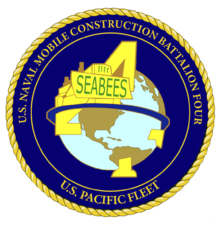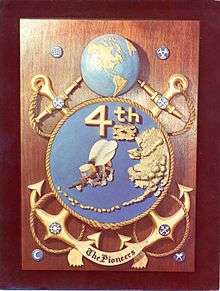Naval Mobile Construction Battalion Four
| Naval Mobile Construction Battalion 4 | |
|---|---|
 NMCB 4 Insignia | |
| Active | 11 May 1942 – present |
| Country | United States |
| Branch | USN |
| Size | 600 |
| Part of | 30th Naval Construction Regiment |
| Homeport | CBC Port Hueneme |
| Nickname(s) | "Fabulous Four" |
| Motto(s) | "We Build, We Fight" "CAN DO" |
| Mascot(s) | SEABEE – From CB or Construction Battalion |
| Engagements |
World War II Vietnam War Operation Enduring Freedom Operation Iraqi Freedom |
| Commanders | |
| Current commander | Commander J.J. Cho, CEC |
Naval Mobile Construction Battalion FOUR (NMCB 4) is a Navy Seabee battalion based out of Port Hueneme, California.[1] Nicknamed the "Fabulous Four", it is one of the oldest active NMCBs in the Navy.

History
U.S. Naval Mobile Construction Battalion FOUR was commissioned on 11 May 1942. Starting with 32 officers and 1,073 enlisted men, MCB 4's first assignment in World War II was to build advanced bases in the frozen arctic of Alaska and the Aleutian Islands.
1940s through 1970s
In 1944, twenty-six men landed in Guam on D-day plus six and began building bases on the island. The balance of the Battalion soon followed. By 1945, NMCB Four had moved to Okinawa to build roads, camps and a large ship repair facility in Baten, Korea. After the war's end, NMCB Four was decommissioned as part of the nations armed forces reduction.
On 12 February 1951, an order was given to a reactivate U.S. Naval Mobile Construction Battalion FOUR. NMCB Four was recommissioned 9 March 1951, at the U.S. Naval Yards and Docks, Norfolk, Virginia with eight officers and 282 enlisted men. NMCB Four was home ported in Davisville, R.I., and deployed to such diverse locales as: Bermuda; Port Lyautey, Morocco; Naples, Italy; Guantanamo Bay, Cuba; Trinidad; Ecuador; Newfoundland, Canada; Puerto Rico; Holy Loch, Scotland and Rota, Spain.
In 1962, NMCB Four was called into action at U.S. Naval Station Guantanamo Bay, Cuba, when the threat of attack from the Communist regime seemed imminent. Throughout the alert, the Seabees of NMCB Four worked with great speed fortifying the base's perimeter and assisting the Marines in base defense.
NMCB Four conducted four tours during the Vietnam War. In December 1965, the Battalion flew to Chu Lai, Vietnam. This was to be the first of many invaluable operations performed in Vietnam. In Chu Lai, Four repaired monsoon-ravaged airfields, installed runway lighting systems for night operations and built a helicopter-landing pad. A detachment was also sent to the Kham Duc Airfield near the Laotian border. In August 1966 the Battalion returned to its new homeport in Port Hueneme for leave and retraining.
The second Vietnam deployment was to Da Nang in March 1967. The Battalion worked at the Da Nang Air Base, dug wells at the Special Forces Camp at Con Thien and built a galley for the Marines. NMCB Four returned to Port Hueneme in October. Four months later in February 1968, the Battalion returned to Vietnam.
During its third deployment, the Battalion did essential construction projects along the Vietnam coastline and Highway 1. At Quang Tri and Camp Evans, the Seabees built facilities for Commander, Naval Forces Vietnam. Approximately half the Battalion redeployed to the Da Nang area. The other half went south to the region of Phu Bai. Key Phu Bai projects included constructing aircraft revetments, laying 85,000 square feet (7,900 m2) of steel aircraft matting for the Marine Air Group strip and laying 18 miles (29 km) of eight-inch (203 mm) fuel line from Wunder Beach to Quang Tri.
In the north, the other detachment at Camp Haines built the Army's Camp Evans. The Battalion erected nearly 1,000 wooden buildings, resurfaced and matted a 2,900-foot (880 m) aircraft runway, and constructed 23 miles (37 km) of eight-inch (203 mm) oil supply line. In October, NMCB Four returned to the United States after having one of the busiest deployments of any battalion in Vietnam. It then conducted a fourth tour in Vietnam from April 1969 to December 1969.
In the 1970s, NMCB Four deployed to such places as Diego Garcia, Guam, Hawaii, and Japan. During this decade, the Battalion completed over 3,800 structures at the Guam relocation site for Vietnamese refugees during Operation New Life in 1975.
The Battalion was called into action again after Typhoon Tip destroyed the U.S. Marine Barracks at Camp Fuji in 1979. The Seabees rebuilt the barracks and operated a Military Affiliate Radio Station until normal lines of communication were restored.
1980s through present
The 1980s brought the Battalion to new regions around the world including Bahrain, Greece, Crete, Palau, Yap (U.S. Trust Territories), Egypt, Kusco, Panama, Costa Rica, Africa, Korea, and Sicily. In 1989, the Battalion's Air Detachment participated in Operation TEAM SPIRIT, providing contingency construction support to the 3rd Marine Expeditionary Force (III MEF) at Camp Pohang, Republic of Korea.
NMCB Four redeployed from Camp Moscrip, Naval Station Roosevelt Roads, Puerto Rico to Camp Rohrbach, Saudi Arabia during Operation Desert Shield in August 1990. While redeployed, the battalion set up a 2,000-man tent camp, built a 3,600-foot (1,100 m) taxiway, 20 hides (parking stalls) and other projects in support of U.S. and Allied Forces in the Middle East. On 15 June 1991, responding to the eruption of Mount Pinatubo, NMCB Four mobilized from its deployment site at Camp Shields, Okinawa, to the Republic of the Philippines. The battalion worked around the clock the help the Subic Bay Naval Complex recover by clearing roadways and collapsed buildings, restoring utilities and building shelters in the area devastated by 12 inches (300 mm) of volcanic ash.
In the wake of Hurricane Andrew on 24 August 1992, the battalion mounted out a 150-man Air Detachment and conducted the largest Seabee airlift ever as part of the disaster relief efforts in the communities of Homestead and Florida City, Florida. NMCB Four, along with nine other Seabee units, reopened a local school, cleared debris, restored utility services and provided valuable assistance to private residences, government facilities and volunteer organizations.
In December 1994, NMCB Four deployed to Guantanamo Bay, Cuba, in support of Operation Sea Signal to construct facilities for 20,000 Cuban migrants. The 35 million dollar quality of life improvement program consisted of two cities on 125 and 150-acre (0.61 km2) sites. Work included constructing 1,341 strong back tents, building 67 concrete block buildings, installing over 17 miles (27 km) of underground piping and 53 miles (85 km) of electrical cable and placing 11,700 cubic yards (8,900 m3) of concrete.
In 2002, NMCB Four sent its Air Detachment and Water Well Team to Basilian Island, Philippines, in support of Operation Enduring Freedom - Philippines. The Air Detachment repaired roads, constructed C huts, bridges and helicopter landing zones and installed water wells to support U.S. Forces.
During the 2003 deployment, NMCB Four deployed to Iraq in support of Operation Iraqi Freedom (OIF) I to help sustain combat during combat operations, during this time NMCB 4 built and maintained roads, schools, police stations, prisons, and fire stations. NMCB 4 also constructed 6 Mabey Johnson bridges, pulled security and drove convoy missions from Kuwait to northern most cities of Iraq.
NMCB Four is currently forward deployed to the United States Pacific Command (PACOM).
In 2012 NMCB Four made history, while deployed in Afghanistan at the Air Field when eight women joined to form the first all-female unit. They were tasked with building two 20 by 32-foot B-hut at the village stability platform in Malozai, Helmand province, Afghanistan. Women first joined the Seabees in 1972 and by 1994 were working and serving alongside their male counterparts in the field.[2]
Unit awards
 Navy Unit Commendation : – Vietnam
Navy Unit Commendation : – Vietnam  Navy Unit Commendation : – Vietnam
Navy Unit Commendation : – Vietnam  Navy Unit Commendation : – Vietnam
Navy Unit Commendation : – Vietnam  Joint Meritorious Unit Award : –
Joint Meritorious Unit Award : –  Republic of Vietnam Civil Actions Medal Unit Citation
Republic of Vietnam Civil Actions Medal Unit Citation Republic of Vietnam Gallantry Cross with Palm Unit Award
Republic of Vietnam Gallantry Cross with Palm Unit Award Presidential Unit Citation (Philippines); - 2002 Exercise Balikatan 02-1
Presidential Unit Citation (Philippines); - 2002 Exercise Balikatan 02-1 Presidential Unit Citation : – Iraq 2003
Presidential Unit Citation : – Iraq 2003 Army Meritorious Unit Commendation : - Iraq 2008-09
Army Meritorious Unit Commendation : - Iraq 2008-09 Army Meritorious Unit Commendation : - Iraq 2010
Army Meritorious Unit Commendation : - Iraq 2010 Navy "E" Ribbon : – U.S. Atlantic Fleet Battle "E" 12 times.[3]
Navy "E" Ribbon : – U.S. Atlantic Fleet Battle "E" 12 times.[3]- Peltier Award: - 6 times
Service & campaign awards
- Asiatic-Pacific Campaign Medal with two bronze stars device : - Aleutians, Guam, Okinawa



 World War II Victory Medal
World War II Victory Medal Vietnam Campaign Medal service ribbon with 60– Device : - 4 awards
Vietnam Campaign Medal service ribbon with 60– Device : - 4 awards Vietnam Service Medal
Vietnam Service Medal Humanitarian Service Medal : – USA Hurricane Katrina 2005
Humanitarian Service Medal : – USA Hurricane Katrina 2005
Chief of Naval Operations Awards page Vietnam
See also
- Naval Mobile Construction Battalion 1
- Seabee
- Naval Construction Battalion Center Port Hueneme
- Amphibious Construction Battalion One (ACB-1)
- Amphibious Construction Battalion Two (ACB-2) – Naval Amphibious Base Little Creek#Major shore commands (at "Naval Construction Force")
| Wikimedia Commons has media related to Naval Mobile Construction Battalion 4. |
References
- ↑ https://www.seabee.navy.mil/index.cfm/8685
- ↑ "Defense video and imagery distribution system". dvidshub.net. 14 January 2012. Retrieved 2 March 2016.
- ↑ Battle "E" Peltier Perry Awards, Seabee Museum Archives, Port Hueneme, CA 93043 |
External links
- NMCB 4 Facebook
- Official USN webpage
- NAVDOCKS-100, January 1944, U.S.Naval Construction Battalion Administration Manual